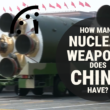New era, same arguments
By Klaus Janberg, April 17, 2015
Life offers wonderful surprises, even when you reach old age. In my roundtable colleague Hui Zhang, I have discovered a Chinese “twin” in spirit! In fact, I would address to our colleagues Baldev Raj and P.R. Vasudeva Rao the question at the heart of Zhang's Round One essay: Why rush into breeders and reprocessing? Why advance the same arguments that were advanced in the 1960s and 1970s—when, over the decades, these arguments have proven unsound in multiple countries?
Raj and Rao base much of their Round One essay on the idea that global uranium resources are inadequate. But uranium ore, in constant dollars, is cheaper today than in the past. True, prices increased just before Fukushima, but afterwards fell so low that many mines couldn't cover their costs. Production had to be reduced and mining operations had no incentive for further exploration. Until mines can invest again, supplies will be short and prices will rise—but short-term fluctuations aside, the uranium industry today finds it challenging just to survive.
Proven, easily accessible reserves of uranium will be adequate to meet demand for decades to come. But Raj and Rao choose to analyze fuel supply over a very long time scale—writing "one must conclude that uranium-based fission energy cannot … last for more than a few centuries." Even if this is true, it expresses an incredible lack of trust in market forces and human ingenuity. History has shown time and again that if human beings face an urgent need, a path toward meeting that need will be discovered. Or existing methods will be improved so that extra time is gained for research and development.
Indeed, many energy technologies under development today may reduce the need for fission energy in the future. I won't argue that photovoltaic cells, for example, are the answer—but their efficiency is steadily improving and their capital costs are decreasing, while nuclear reactors are growing more expensive (for new reactors at Finland's Olkiluoto plant and France's Flamanville facility, costs have more than tripled). For that matter, do Raj and Rao believe that humanity won't deliver adequate electricity storage systems within the next, say, 15 to 20 years? What pessimism for researchers to display!
In any event, if plutonium is to be the answer to a possible uranium shortage in the future, significant stockpiles of plutonium already exist. The United Kingdom has on hand more than 110 metric tons of civilian plutonium—and no reactors in which the fuel is used. Japan has a stockpile of about 47 metric tons (stored in Japan and elsewhere). France is home to more than 20 metric tons of plutonium. These stockpiles constitute a very meaningful buffer against future shortages of nuclear fuel.
Raj and Rao also argue for reprocessing on the basis of its purported benefits in nuclear waste reduction, maintaining that a once-through cycle results in a larger volume of waste than does the closed fuel cycle. They're correct—if one focuses only on spent fuel and has in mind the heat released in disposal mines. But reprocessing also involves discharges of liquid and gaseous wastes into the environment. Then there are the vitrified wastes that reprocessing entails; the hulls and structures of spent-fuel assemblies that must be disposed of; and the solidified residues of the reprocessing process itself. For the sake of completeness, one should also mention the waste that ultimately results from dismantling a reprocessing facility. These waste streams make the once-through cycle clearly superior in terms of waste volumes. Pyroprocessing will not alter this reality in any significant way.
Finally, there is the proliferation issue. Raj and Rao write that "Proliferation concerns no longer constitute a convincing rationale for adopting a once-through fuel cycle." Perhaps for India, which hasn't signed the Nuclear Non-Proliferation Treaty, proliferation doesn't seem so important a concern. But it has been a grave concern for many other countries since India's "peaceful" nuclear detonation in 1974. That detonation, which used plutonium reprocessed from spent reactor fuel, was the ignition point for nuclear programs in Pakistan, North Korea, Libya, Iraq, and perhaps others countries not yet recognized. I concede that nowadays it may be easier for some nations to produce fissile material through uranium enrichment. But reprocessing, even if it doesn't achieve full separation of uranium and plutonium from spent fuel, still provides the easiest route to a "dirty bomb"—and a quick route too, complicating surveillance efforts. I believe that the proliferation risks associated with reprocessing still exist—and are in fact increasing.
Topics: Nuclear Energy, Nuclear Weapons
Share: [addthis tool="addthis_inline_share_toolbox"]














